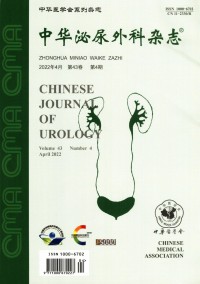The application and outcomes of C. R.P.C. four-step radical prostatectomy under extraperitoneal laparoscopy
Q4 Medicine
引用次数: 0
Abstract
Objective To summarize the preliminary experience of extraperitoneal laparoscopic radical prostatectomy (C.R.P.C. four-step) for localized prostate cancer and the outcomes based on early follow-up. Methods A total of 102 prostate cancer patients were screened by prostate specific antigen (PSA) and diagnosed by prostate magnetic resonance imaging and prostatic puncture biopsy with cT1c-cT3b, with average age of (67±5) years old, average preoperative total PSA value of (45.32±18.33) ng/ml, and average prostate volume was (42±12)cm3. All these patients underwent extraperitoneal laparoscopic radical prostatectomy by the four-step technique, abbreviating as C. R.P.C.[C: control DVC (dorsal deep venous complex). R: recognize three anatomical layers (prostate and bladder junction, seminal vesicle, and Denonvilliers’fascia surface). P: preserve urethral sphincter and bladder neck. C: continuous anastomosis between urethra and bladder neck (4 key needles at 3, 5, 7 and 9 o’clock)]. The operative time, estimated blood loss, length of hospital stay and postoperative complications were recorded, and the postoperative PSA was followed up. Results All the 102 cases were successfully treated by laparoscopic radical prostatectomy. The operative time was from 55 to 156 min (mean 92 min), and the estimated blood loss was from 55 to 185 ml (mean 105 ml). There was no case converted of open surgery, only one case received blood transfusion for postoperative hemorrhage (0.98%), and positive surgical margin was found in 15 case (14.70%) by pathological examination. Postoperative urinary extravasation within one week occurred in 2 (1.96%) cases, and resolved after tensioning the catheter and prolonging the indwelling time. During the follow-up period of 12 to 45 months, 2 cases were incontinent (grade Ⅰ-Ⅱ), and the other cases(98.04%) had no incontinence or dysuria . However, 11 cases(10.78%) developed to biochemical recurrence within 6 months after the operation. Conclusions The C. R.P.C. four-step technique of lparoscopic radical prostatectomy is easily to be grasped and performed by the greenhand urologists, and was efficient and safe. Key words: Prostatic neoplasms; Radical prostatectomy; Extraperitoneal laparoscopy; Prostate cancer; Four-step method; Curative effect腹膜外腹腔镜下C.R.P.C.四步前列腺根治术的应用及效果
目的总结腹腔镜下四步根治性前列腺切除术治疗局限性前列腺癌的初步经验及早期随访的效果。方法对102例前列腺癌患者进行前列腺特异抗原(PSA)筛查,经前列腺磁共振成像和前列腺穿刺活检诊断,检测结果为cT1c-cT3b,平均年龄(67±5)岁,平均术前总PSA值(45.32±18.33)ng/ml,平均前列腺体积(42±12)cm3。所有患者均行腹腔外腹腔镜根治性前列腺切除术,采用四步技术,简称为c.r.p.c. [C: control DVC (dorsal deep venous complex)]。R:识别三个解剖层(前列腺与膀胱交界处、精囊、德农维利氏筋膜表面)。保尿道括约肌及膀胱颈。C:尿道与膀胱颈间连续吻合(3、5、7、9点钟方向4根键针)。记录手术时间、预计出血量、住院时间及术后并发症,并随访术后PSA。结果102例患者均成功行腹腔镜根治性前列腺切除术。手术时间55 ~ 156 min(平均92 min),估计失血量55 ~ 185 ml(平均105 ml)。无中转开腹手术,术后出血输血1例(0.98%),病理检查手术切缘阳性15例(14.70%)。术后1周内发生尿外渗2例(1.96%),经拉紧导尿管并延长留置时间后,尿外渗得以缓解。随访12 ~ 45个月,2例出现尿失禁(级别Ⅰ~Ⅱ),其余98.04%无尿失禁或排尿困难。术后6个月内生化复发11例(10.78%)。结论腹腔镜根治性前列腺切除术的四步法易于泌尿外科新手掌握和操作,安全有效。关键词:前列腺肿瘤;根治性前列腺切除术;Extraperitoneal腹腔镜检查;前列腺癌;四个步骤的方法;疗效
本文章由计算机程序翻译,如有差异,请以英文原文为准。
求助全文
约1分钟内获得全文
求助全文
来源期刊

中华泌尿外科杂志
Medicine-Nephrology
CiteScore
0.10
自引率
0.00%
发文量
14180
期刊介绍:
Chinese Journal of Urology (monthly) was founded in 1980. It is a publicly issued academic journal supervised by the China Association for Science and Technology and sponsored by the Chinese Medical Association. It mainly publishes original research papers, reviews and comments in this field. This journal mainly reports on the latest scientific research results and clinical diagnosis and treatment experience in the professional field of urology at home and abroad, as well as basic theoretical research results closely related to clinical practice.
The journal has columns such as treatises, abstracts of treatises, experimental studies, case reports, experience exchanges, reviews, reviews, lectures, etc.
Chinese Journal of Urology has been included in well-known databases such as Peking University Journal (Chinese Journal of Humanities and Social Sciences), CSCD Chinese Science Citation Database Source Journal (including extended version), and also included in American Chemical Abstracts (CA). The journal has been rated as a quality journal by the Association for Science and Technology and as an excellent journal by the Chinese Medical Association.
 求助内容:
求助内容: 应助结果提醒方式:
应助结果提醒方式:


